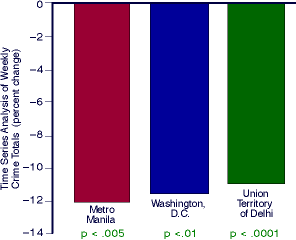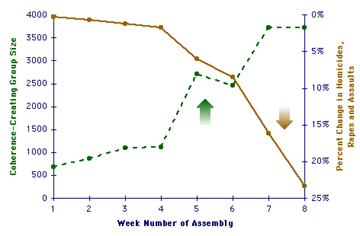Effect on Crime
The first studies on peace-creating groups, as well as the last large demonstration project in Washington, DC, centered on crime. In any society where open warfare or terrorism is not present, crime is the most disorderly and violent disturbance of the peace. If peace-creating assemblies directly create coherence and harmony in the world, therefore, they must surely reduce crime.
The effect on crime produced by such assemblies has been demonstrated in 22 separate studies. Four studies are discussed here, with detail on all the studies available in the In-Depth sections listed at left.
|
| Decreased Crime in the Capital Regions of the
Philippines, the United States, and India |
|
 |
|
Three different demonstrations, combined in this chart, have shown that large peace-creating groups have consistently reduced crime in capital cities around the world. In all three cases, the group gathered for a period of weeks or months, and crime dropped significantly below pre-existing levels. Time series analysis showed that this drop was not to be expected based on prior causative factors, and could not be accounted for by weather, seasonal cycles, or changes in police coverage. Because two of the three groups were composed of Westerners visiting in Asian cities, this study also demonstrated that peace-creating groups apparently operate on a fundamental level that transcends political, cultural or ethnic differences.
References: [For Manila and New Delhi]: The Journal of Mind and Behavior, 8, 67-104. [For Washington, DC:] The Journal of Mind and Behavior, 9, 457–485.
|
| Reduced Violent Crime in Washington, D.C. |
|
 |
|
A National Demonstration Project conducted in Washington, D.C. from June 7 to July 30, 1993, tested the efficacy of a peace-creating group for reducing crime as measured by FBI Uniform Crime Statistics.
In this carefully controlled experiment, an assembly of Transcendental Meditation experts increased from 800 to 4000 over a two-month period. Although violent crime had been steadily increasing during the first five months of the year, and although violent crime usually peaks in the hot weather months, soon after the start of the study, and during a near-record summer heat wave, violent crime began decreasing and continued to drop until the end of the experiment (maximum decrease 23.6%), after which it began to rise again. The likelihood that this result could be attributed to chance variation in crime levels was less than two parts per billion (p < .000000002). The drop in crime could not be attributed to other possible causes, including prior causative factors, temperature, precipitation, weekends, and police and community anti-crime activities (Social Indicators Research 47: 153-201, 1999).
|
To move to the next Summary,
click here:

To continue with more detail on this topic,
click here:

|
|


